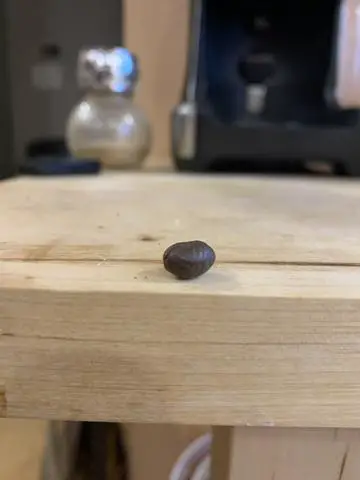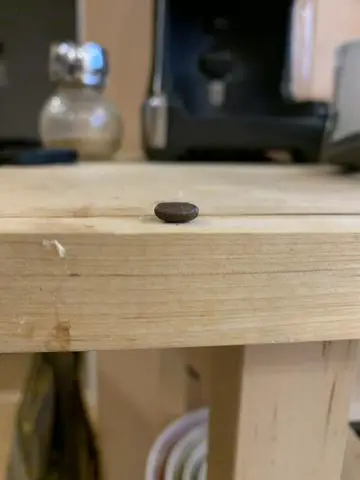What is Peaberry Coffee?
You may have seen a number of coffees marketed as “peaberry coffees”, but what makes peaberry coffee so special?
Referred to as caracolillo in Spanish, a peaberry is actually a special coffee bean- not a different variety or origin, but a case where a normal coffee bean grows differently. Let’s take a look at the mechanics of how a coffee bean grows:
Generally, the “cherry” (a.k.a. the fruit) of a coffee plant consists of two separate “beans”, or seeds (Although, even three seeds/beans is possible!). These beans mature with flattened sides facing each other.
Occasionally though, just one seed inside the cherry gets fertilized. This seed/bean grows without anything flattening it during development. This results in a pea-shaped (or oval-shaped) bean called a “peaberry”.

(Peaberry Coffee bean)
Most peaberries are found in the plant’s extremities. In harsh weather conditions, the transmission of nutrients is slow. Wind, gravity, and pollination agents have more difficulty reaching blossoms in order to fertilize them. It is believed that insects only account for five to ten percent of pollination levels.
Generally, peaberry beans account for about 5% or so of harvested coffee beans.
Roasting Peaberry Beans
The general consensus among roasters is that peaberry beans produce a more balanced roast than their counterpart. Some say this is because the curved form of a peaberry reduces the edges that normally contact unevenly during roasting. Instead, the peaberries roll around the inside of a roasting chamber, yielding a more even roast.
Because normal- flat- beans and peaberry beans do not roast the same way, peaberry beans are often separated from the regular beans beforehand to yield an even roast.

(Normal coffee bean – note the flatter shape)
Origins commonly sold as Peaberry Coffee
Coffees originating from Hawaii (Kona coffee) or West Africa (Tanzania) are often sorted and sold in a peaberry variety. Brazilian coffee is also sometimes offered as peaberry.
Peaberry coffee that comes from West Africa area is said to contain dense notes of black currant with subtle hints of cocoa. Many describe Tanzanian Peaberry specifically as having notes of blackberry, lemon, chocolate, kiwi, and black tea.

In contrast to the average Kona coffee, peaberry Kona coffee is said to have enhanced citrus notes (in addition to a more lightweight body). Many also find Kona peaberry coffee to carry a more complex aroma.

At one time, peaberries were separated from Kona coffee and disposed of pre-roast as they were seen as inferior. Because of their peculiar size and shape, they roasted differently than regular beans, and the roast would see an overall reduction in consistency and quality. Today, sorted peaberry beans are sought for their uniqueness and sold at a premium due to their short supply.
Distinctions in Peaberry Coffee Flavor?
There are people out there who are quite taken with peaberry coffee. These people can talk to you for hours about why a peaberry coffee bean is superior to others.
For instance, you might hear that peaberry beans have a more complex flavor than normal beans. The theory is that the solo seed receives greater nutrient content that enhances the presence of various flavor altering compounds in the bean.
Similarly, others may say that a peaberry bean is significantly sweeter than a normal coffee bean. Proponents of this theory tend to attribute this sweetness to the bean having exclusive access to the fruit/cherry, potentially enhancing its sugar content.
Trying out a Tanzania Peaberry
As we noted in our review article, I recently ordered Stone Street’s Tanzania Whole Bean Peaberry. After grinding the peaberry fresh, I brewed a cup with my Coffee Gator.
Stone Street Tanzania Peaberry definitely had a sweet flavor and with notes reminiscent of a tart jam, potentially raspberry. Personally, I think its a bit too sweet/syrupy for an *everyday* cup, but definitely a very good coffee and absolutely worth a try.
I’d have to try a few more peaberry coffees before saying that it is representative of peaberry coffees generally, but I would say that Stone Street’s Tanzania Peaberry matched the characteristics people typically note regarding peaberry coffees. The taste was quite sweet and the jam like flavor was somewhat unique. A way to describe about the jam-like flavor might be to consider the flavor of a different high acidity, fruity coffee (like a Yirgacheffe) but to reduce the sharpness and increase the sweetness.
If you decide to try it out, let us know in the comments below what you thought!
